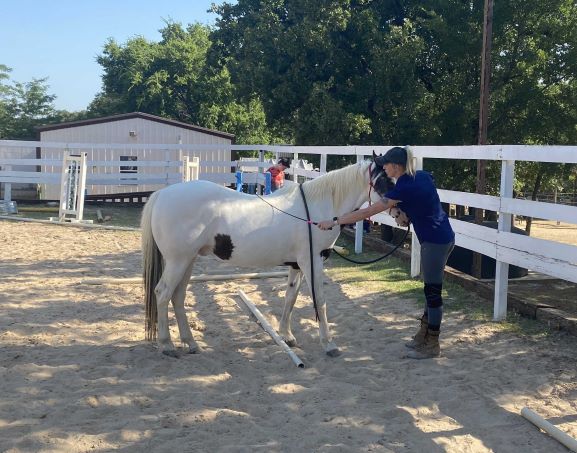"There is something about the outside of the horse that is good for the inside of man"
Winston Churchill

Horses have shown the ability to read, understand, and relay emotional and physical stresses that people are experiencing. That ability to reflect and relay emotions creates an environment between horse and handler where individuals are able to build a stronger sense of security, confidence, and strengthening of coping mechanisms. To help create that environment, New Hope employs both Natural Horsemanship and Horse Speak philosophies.
Once those natural instincts are understood, the participant will learn to mirror the body language horses use with each other in the herd to communicate with their horse. Both Natural Horsemanship and Horse Speak are based upon respect and trust
New Hope’s Horses Helping Heroes program focuses on participants learning to be an active communicator, not a reactive handler. During this process the horse’s ability to read, understand, and relay emotional and physical stresses that people are experiencing provides an opportunity for the participant to naturally find the truth and reality of their own actions and reactions, discoverable by reason and derived from the nature of the horse.
Natural horsemanship is the act of training, managing, and riding horses according to truth and reality, discoverable by reason and derived from the nature of the horse. Natural horsemanship is based upon the truth that the horse has a highly developed communication system expressed through body language, and it is possible for humans to learn to use body language to communicate with the horse. The handler uses body language along with other forms of gentle pressure with increasing escalation to get the horse to respond. Horses are quick to form a relationship of respect with humans who treat them in this manner; “soft as possible, firm when necessary” is the motto of natural horsemanship.
In natural horsemanship, it is important for the handler to be knowledgeable of the horse’s natural instincts and communication system and to use this knowledge in their work with the horse. Condition-response methods through pressure and release are core concepts of natural horsemanship. The basic technique is to apply an aversive pressure whereby horses are motivated to move away from pressure. The reward for the horse is the release of pressure and is a key motivator. The techniques are based on the principle of negative reinforcement rather than punishment by physical force.
Natural horsemanship is a Replacement Concept eliminating the use of the word “don’t.” The handler should replace unwanted behavior with something else that it can do or needs to practice.
Natural horsemanship is based upon respect and trust. Respect happens when the handler can get the horse to perform specific actions on cue, whether it wants to do them or not. Trust is developed from gaining control without inflicting pain. In de-sensitizing the horse according to natural horsemanship methods, the handler uses the Approach and Retreat method which produces a respectful and trusting relationship between the handler and the horse as opposed to the traditional “sacking out” processes which frequently break down the relationship of trust and respect.
In natural horsemanship, the handler practices being an active handler and not a reactive handler. Therefore, the Formula for Success in natural horsemanship methods are: handler’s concentration + handler’s consistency = horse’s consistency + horse’s concentration. The horse will become a mirror image of its handler.
Motivation is the force behind all learning, whether working with people or with animals. A motivator inspires or creates change. Discerning what is the motivator is a critical component of natural horsemanship. – John Lyons, America’s Most Trusted Horseman

Using the Natural Horsemanship philosophy we use the highly developed communication system of the horse expressed through their body language, to teach participants to learn to use body language to communicate back with their horse. This is not psychotherapy, rather it is a groundwork process using the horse’s ability to read, understand, and relay emotional and physical stresses that people are experiencing. This communication feedback cycle provides an opportunity for the participant to naturally find the truth and reality of their own actions and reactions, discoverable by reason and derived from the nature of the horse.
The scheduling of these start of these sessions are flexible depending on the needs or the riders, availability of instructors, volunteers and horses.
Week 1: Foundations in Horsemanship
Week 2: Leading the horse; grooming the horse (not feet)
Week 3: Sensitizing/De-sensitizing the horse
Week 4: Leading through obstacle course/ Round penning
Week 5: Round penning and ground warm-up
Week 6: Ground Warm up & Ground Exercises
Week 7: Ground/Mounted lessons
Week 8: Ground/Mounted lessons / Session wrap

“Round Pen Basics,” from John Lyons’ Ground Control Teaching Manual for Unbroke and Broke Horses; and his article https://beaconseniornews.com/cover-story/john-lyons-the-story-of-americas-most-trusted-horsemanship/
Communicating with Cues: The Rider’s Guide to Training and Problem Solving, Part 1, by John Lyons.
Clinton Anderson’s Downunder Horsemanship, Establishing Respect and Control for English and Western Riders by Clinton Anderson with Ami Hendrickson, 2004
Riding Through Recovery, Mt. Rainier Therapeutic Riding Center, Veterans curriculum
CHA (Certified Horsemanship Association) Horsemanship Composite Manual: Level 1 & 2
CHA The Art of Teaching
© 2022 New Hope Equine Assisted Therapy.